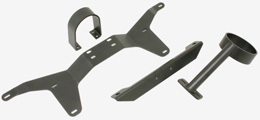Rear Driveshaft

Part : RDS
In front-engined, rear-drive vehicles, a longer drive shaft is also required to send power the length of the vehicle. Two forms dominate: The torque tube with a single universal joint and the more common Hotchkiss drive with two or more joints. This system became known as Système Panhard after the automobile company, Panhard et Levassor patented it.
Most of these vehicles have a clutch and gearbox (or transmission) mounted directly on the engine with a drive shaft leading to a final drive in the rear axle. When the vehicle is stationary, the drive shaft does not rotate. A few, mostly sports cars seeking improved weight balance between front and rear and most commonly Alfa Romeos or Porsche 924s, have instead used a rear-mounted transaxle. This places the clutch and transmission at the rear of the car and the drive shaft between them and the engine. In this case the drive shaft rotates continuously as long as the engine does, even when the car is stationary and out of gear.
Early automobiles often used chain drive or belt drive mechanisms rather than a drive shaft. Some used electrical generators and motors to transmit power to the wheels.